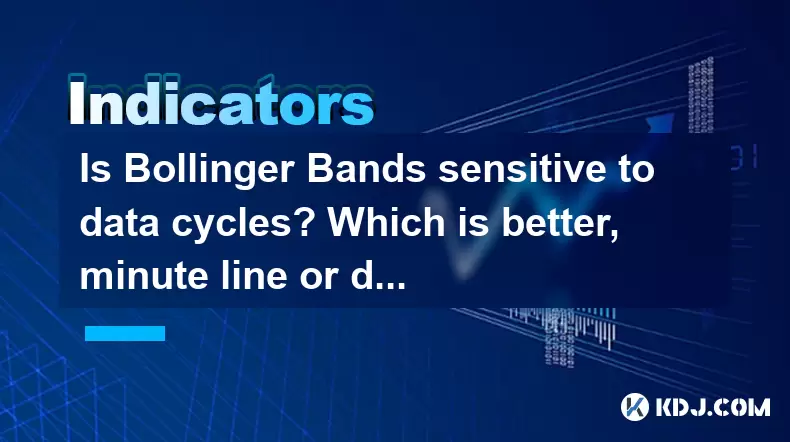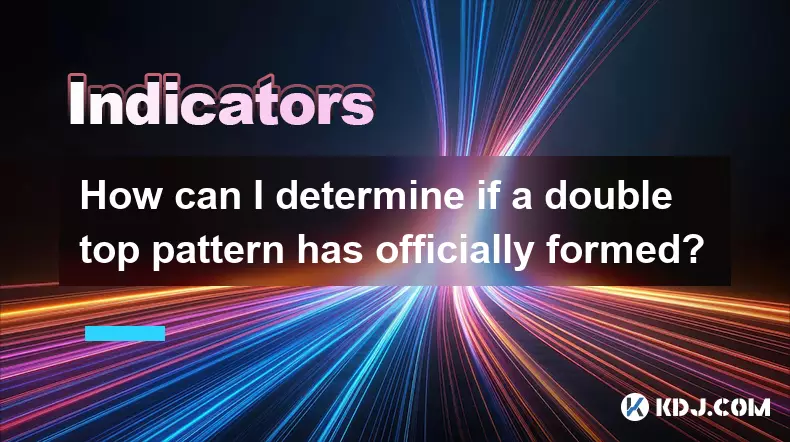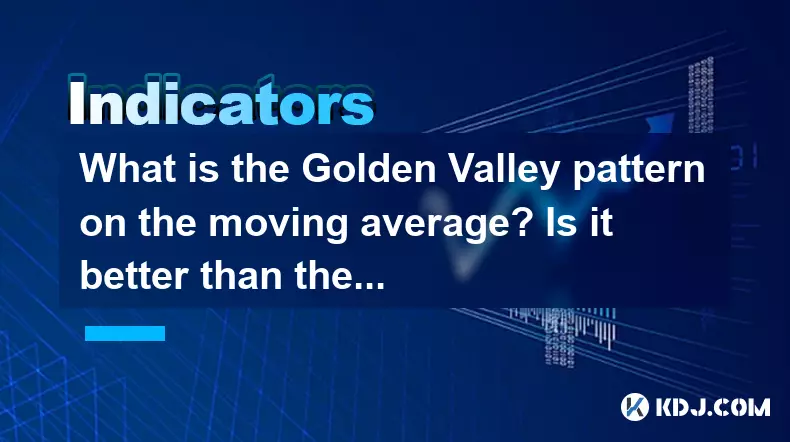-
 bitcoin
bitcoin $114779.865156 USD
2.30% -
 ethereum
ethereum $4226.519789 USD
2.39% -
 tether
tether $1.000545 USD
0.04% -
 xrp
xrp $2.890223 USD
0.92% -
 bnb
bnb $1030.029301 USD
2.95% -
 solana
solana $212.824944 USD
1.69% -
 usd-coin
usd-coin $0.999757 USD
0.01% -
 dogecoin
dogecoin $0.234961 USD
-0.27% -
 tron
tron $0.337174 USD
0.42% -
 cardano
cardano $0.804783 USD
0.09% -
 hyperliquid
hyperliquid $45.748770 USD
-2.85% -
 chainlink
chainlink $21.699170 USD
0.82% -
 ethena-usde
ethena-usde $1.001452 USD
0.08% -
 avalanche
avalanche $30.237800 USD
1.14% -
 stellar
stellar $0.372604 USD
1.52%
Is Bollinger Bands sensitive to data cycles? Which is better, minute line or daily line?
Bollinger Bands' sensitivity to data cycles impacts their effectiveness; minute lines suit short-term trades, while daily lines are better for long-term strategies.
May 21, 2025 at 11:56 pm

Introduction to Bollinger Bands
Bollinger Bands are a popular technical analysis tool used by traders in the cryptocurrency market to assess market volatility and potential price movements. Developed by John Bollinger, these bands consist of a middle band being a simple moving average (SMA) and two outer bands that are standard deviations away from the middle band. The sensitivity of Bollinger Bands to data cycles can significantly impact their effectiveness in trading strategies. This article will explore the sensitivity of Bollinger Bands to different data cycles and compare their performance using minute lines versus daily lines.
Understanding Bollinger Bands Sensitivity
Sensitivity to data cycles refers to how responsive Bollinger Bands are to the frequency and volume of data points used in their calculation. The choice of data cycle—whether it's minutes, hours, or days—can greatly affect the bands' ability to provide timely and accurate signals.
When using shorter time frames such as minute lines, Bollinger Bands can become highly sensitive to market fluctuations. This sensitivity can be beneficial for traders looking to capitalize on short-term price movements but can also lead to more false signals due to the increased noise in the data. Conversely, using longer time frames like daily lines tends to smooth out these fluctuations, providing a clearer picture of the market's overall trend but at the cost of slower signal generation.
Comparing Minute Lines and Daily Lines
To understand which time frame is better suited for Bollinger Bands, we need to consider the trading objectives and market conditions. Minute lines offer a granular view of price action, making them ideal for day traders and scalpers who thrive on quick, short-term trades.
- Using minute lines:
- Open your trading platform and select the cryptocurrency pair you wish to analyze.
- Navigate to the chart settings and choose a 1-minute or 5-minute time frame.
- Apply Bollinger Bands to the chart. Typically, the default settings are a 20-period SMA with two standard deviations for the upper and lower bands.
- Monitor the bands closely for potential trading signals, such as price touching or breaking through the bands.
On the other hand, daily lines are more suited for swing traders and long-term investors who are interested in capturing larger price movements over extended periods.
- Using daily lines:
- Open your trading platform and select the same cryptocurrency pair.
- Switch to a daily time frame in the chart settings.
- Apply Bollinger Bands using the same settings as for minute lines.
- Analyze the bands for longer-term trends and potential breakout or reversal signals.
Sensitivity to Market Volatility
The sensitivity of Bollinger Bands to market volatility is another critical factor to consider. High volatility markets can cause the bands to widen significantly, providing more space for price movements and potentially leading to more frequent signals. In contrast, low volatility markets result in narrower bands, which can lead to fewer but potentially more reliable signals.
When using minute lines, the impact of volatility is more pronounced. A sudden spike in volatility can cause the bands to expand rapidly, leading to quick but potentially misleading signals. For example, a sudden news event might cause a sharp price movement, triggering a signal on the minute chart but not necessarily reflecting a sustainable trend.
Daily lines, while still affected by volatility, tend to filter out these short-term spikes, providing a more stable view of the market's volatility. This can be advantageous for traders who prefer to avoid the noise associated with intraday fluctuations.
Practical Applications and Trading Strategies
The choice between minute lines and daily lines can significantly influence the trading strategies employed by cryptocurrency traders. Minute line strategies often involve scalping or day trading, where traders aim to profit from small price movements throughout the day.
- Scalping with minute lines:
- Monitor the Bollinger Bands on a 1-minute chart.
- Look for price touching or breaking the lower band as a potential buy signal.
- Set a tight stop-loss just below the lower band and a take-profit target near the middle band.
- Conversely, look for price touching or breaking the upper band as a potential sell signal, with a stop-loss above the upper band and a take-profit near the middle band.
Daily line strategies are better suited for swing trading or position trading, where traders hold positions for days or weeks to capture larger price movements.
- Swing trading with daily lines:
- Analyze the Bollinger Bands on a daily chart.
- Look for price breaking out of the upper band as a potential buy signal, indicating a strong bullish trend.
- Set a stop-loss below the recent swing low and a take-profit target based on technical levels or a risk-reward ratio.
- Conversely, look for price breaking out of the lower band as a potential sell signal, indicating a strong bearish trend, with a stop-loss above the recent swing high.
Conclusion and FAQs
In conclusion, the sensitivity of Bollinger Bands to data cycles is a crucial consideration for cryptocurrency traders. Minute lines offer high sensitivity and are suitable for short-term trading, while daily lines provide a more stable view, ideal for longer-term strategies. The choice between the two ultimately depends on the trader's objectives and market conditions.
Frequently Asked Questions
Can Bollinger Bands be used on other time frames besides minutes and days?Yes, Bollinger Bands can be applied to various time frames, including hours, weeks, and even months. The choice of time frame depends on the trader's strategy and the market being analyzed.
How do I adjust the settings of Bollinger Bands for different cryptocurrencies?While the default settings (20-period SMA with two standard deviations) are commonly used, you can adjust these parameters based on the specific volatility and trading characteristics of different cryptocurrencies. For more volatile assets, you might increase the number of standard deviations to reduce false signals.
Are there any other indicators that work well with Bollinger Bands?Yes, many traders combine Bollinger Bands with other indicators such as the Relative Strength Index (RSI) or Moving Average Convergence Divergence (MACD) to enhance their trading signals. For example, using RSI to confirm overbought or oversold conditions when the price touches the Bollinger Bands.
How can I avoid false signals when using Bollinger Bands?To minimize false signals, consider using additional confirmation tools like trend lines, support and resistance levels, or other technical indicators. Also, be mindful of the market context and avoid trading during times of high volatility or significant news events that can cause erratic price movements.
Disclaimer:info@kdj.com
The information provided is not trading advice. kdj.com does not assume any responsibility for any investments made based on the information provided in this article. Cryptocurrencies are highly volatile and it is highly recommended that you invest with caution after thorough research!
If you believe that the content used on this website infringes your copyright, please contact us immediately (info@kdj.com) and we will delete it promptly.
- BlockDAG, DOGE, HYPE Sponsorship: Crypto Trends Shaping 2025
- 2025-10-01 00:25:13
- Deutsche Börse and Circle: A StableCoin Adoption Powerhouse in Europe
- 2025-10-01 00:25:13
- BlockDAG's Presale Buzz: Is It the Crypto to Watch in October 2025?
- 2025-10-01 00:30:13
- Bitcoin, Crypto, and IQ: When Genius Meets Digital Gold?
- 2025-10-01 00:30:13
- Stablecoins, American Innovation, and Wallet Tokens: The Next Frontier
- 2025-10-01 00:35:12
- NBU, Coins, and Crypto in Ukraine: A New Yorker's Take
- 2025-10-01 00:45:14
Related knowledge

What is a tower bottom candlestick pattern? Does it have a high success rate?
Sep 22,2025 at 07:18am
Tower Bottom Candlestick Pattern Explained1. The tower bottom candlestick pattern is a reversal formation that typically appears at the end of a downt...

What is a black hole pattern in the MACD indicator? Is it a cause for concern?
Sep 21,2025 at 06:54pm
Bitcoin's Role in Decentralized Finance1. Bitcoin remains the cornerstone of decentralized finance, serving as a benchmark for value and security acro...

How can I use the psychological line (PSY) to determine market sentiment?
Sep 17,2025 at 02:19pm
Understanding the Psychological Line (PSY) in Cryptocurrency TradingThe Psychological Line, commonly referred to as PSY, is a momentum oscillator used...

How can I determine if a double top pattern has officially formed?
Sep 21,2025 at 03:18am
Understanding the Structure of a Double Top Pattern1. A double top pattern consists of two distinct peaks that reach approximately the same price leve...

What is the Golden Valley pattern on the moving average? Is it better than the Silver Valley pattern?
Sep 21,2025 at 02:54pm
Understanding the Golden Valley Pattern in Moving Averages1. The Golden Valley pattern is a technical formation observed in cryptocurrency price chart...

What does a death cross of the RSI in the strong zone (above 50) mean?
Sep 17,2025 at 10:54pm
Understanding the Death Cross in RSI Context1. The term 'death cross' is traditionally associated with moving averages, where a short-term average cro...

What is a tower bottom candlestick pattern? Does it have a high success rate?
Sep 22,2025 at 07:18am
Tower Bottom Candlestick Pattern Explained1. The tower bottom candlestick pattern is a reversal formation that typically appears at the end of a downt...

What is a black hole pattern in the MACD indicator? Is it a cause for concern?
Sep 21,2025 at 06:54pm
Bitcoin's Role in Decentralized Finance1. Bitcoin remains the cornerstone of decentralized finance, serving as a benchmark for value and security acro...

How can I use the psychological line (PSY) to determine market sentiment?
Sep 17,2025 at 02:19pm
Understanding the Psychological Line (PSY) in Cryptocurrency TradingThe Psychological Line, commonly referred to as PSY, is a momentum oscillator used...

How can I determine if a double top pattern has officially formed?
Sep 21,2025 at 03:18am
Understanding the Structure of a Double Top Pattern1. A double top pattern consists of two distinct peaks that reach approximately the same price leve...

What is the Golden Valley pattern on the moving average? Is it better than the Silver Valley pattern?
Sep 21,2025 at 02:54pm
Understanding the Golden Valley Pattern in Moving Averages1. The Golden Valley pattern is a technical formation observed in cryptocurrency price chart...

What does a death cross of the RSI in the strong zone (above 50) mean?
Sep 17,2025 at 10:54pm
Understanding the Death Cross in RSI Context1. The term 'death cross' is traditionally associated with moving averages, where a short-term average cro...
See all articles










































































